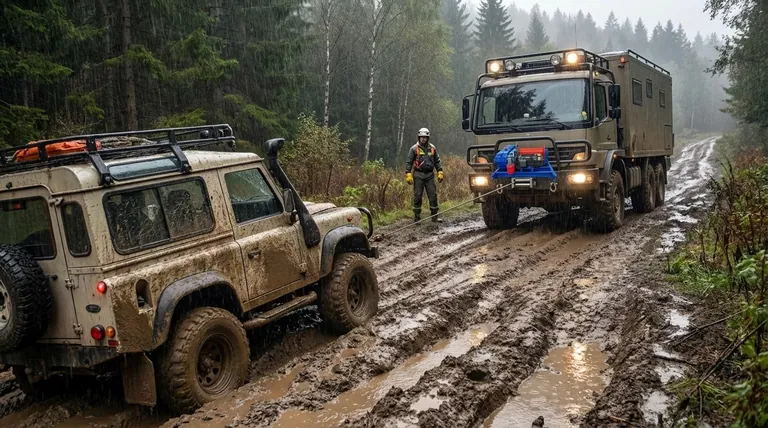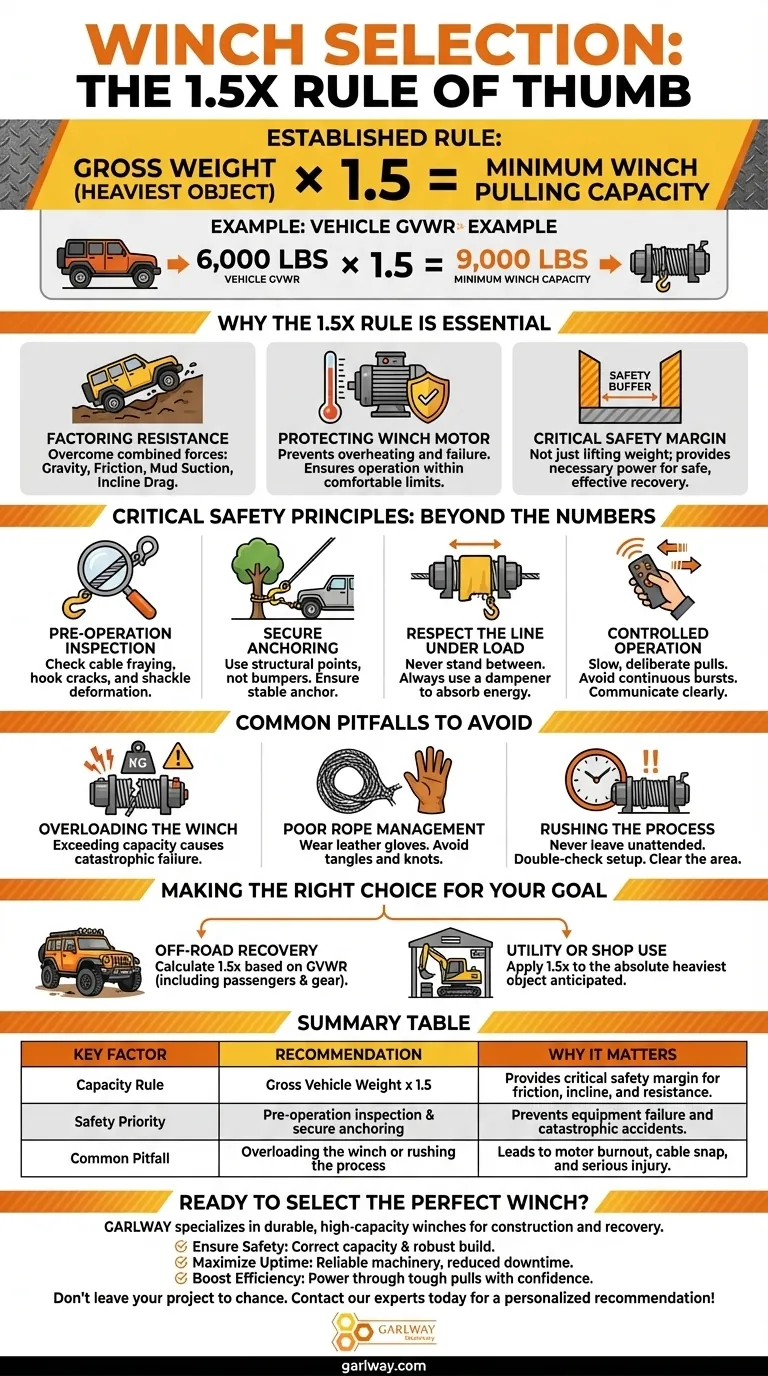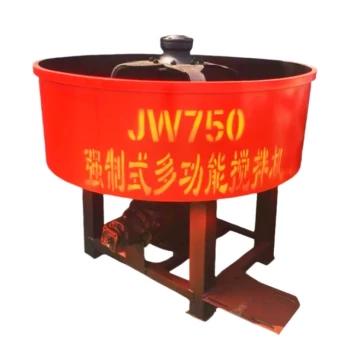The established rule of thumb for selecting a winch is to multiply the gross weight of the heaviest object you plan to pull by 1.5. For example, if your vehicle's Gross Vehicle Weight Rating (GVWR) is 6,000 pounds, you need a winch with a minimum pulling capacity of 9,000 pounds. This simple calculation provides a crucial safety and performance margin for real-world conditions.
The 1.5x capacity rule is not just about lifting a weight; it's about overcoming the combined forces of gravity, friction, and resistance from elements like mud or an incline. This formula provides the minimum power needed for a safe and effective recovery.

Why the 1.5x Rule is Just a Starting Point
The extra capacity mandated by the 1.5x rule isn't for show. It's a critical buffer that accounts for the complex physics of pulling an object that isn't just hanging freely.
Factoring in Real-World Resistance
When a vehicle is stuck, you are pulling against more than just its curb weight. You must overcome the suction of mud, the drag of an object on the ground, or the added force required to pull up an incline. These factors can easily increase the required pulling force far beyond the vehicle's actual weight.
Protecting the Winch Motor
Consistently operating a winch at its maximum rated capacity places enormous strain on its electric motor and mechanical components. This leads to overheating, reduced lifespan, and potential failure when you need it most. The 1.5x rule ensures the winch operates comfortably within its limits during a typical pull.
Critical Safety Principles: Beyond the Numbers
Choosing the right capacity is the first step. Operating it safely is what truly matters. A winch is a powerful tool that demands respect and adherence to proven safety protocols.
Pre-Operation Inspection is Non-Negotiable
Before any pull, you must inspect all your equipment. Look for any fraying or damage on the winch cable or rope. Check that hooks and shackles are free of cracks or deformation. A failure in any single component can lead to a catastrophic accident.
Secure Anchoring is Everything
The winch is only as strong as what it's anchored to. For vehicle recovery, always attach the winch hook to a structural recovery point on the stuck vehicle's frame, not a cosmetic bumper or tie-down loop. Your anchor point (like a tree or another vehicle) must be unquestionably stable and capable of withstanding the load.
Respect the Line Under Load
The winch cable stores an immense amount of kinetic energy when under tension. If it breaks, it can whip through the air with lethal force. Never stand between the winch and its anchor point. Always lay a winch dampener, heavy blanket, or floor mat over the middle of the cable to absorb energy in case of a snap.
Controlled and Deliberate Operation
Winching is not a race. Operate the winch with slow, controlled pulls, and never winch in long, continuous bursts, which can overheat the motor. Ensure the cable is winding evenly onto the drum to prevent binding and damage. Clear and constant communication between the operator and anyone assisting is essential.
Common Pitfalls to Avoid
Mistakes during winch operation can lead to severe equipment damage or serious injury. Understanding these common errors is key to preventing them.
Overloading the Winch
Never attempt to pull a load that exceeds your winch's rated capacity. This is the fastest way to cause a catastrophic failure of the motor, gearbox, or cable. If a pull seems too difficult, you need to rethink your technique, not force the equipment.
Poor Rope Management
Never grab a wire rope with bare hands, as sharp frays can cause serious injury. Always wear thick leather gloves. Avoid allowing the rope to become tangled or knotted, as this creates weak points that can easily break under load.
Rushing the Process
Never leave the winch unattended while it is under load. The situation can change in an instant. Take your time with the setup, double-check all connections, and clear the area of all non-essential people before beginning the pull.
Making the Right Choice for Your Goal
Applying these principles correctly depends on your specific use case.
- If your primary focus is off-road vehicle recovery: Calculate the 1.5x rule based on your vehicle's Gross Vehicle Weight Rating (GVWR), not its curb weight, to account for passengers and gear.
- If your primary focus is utility or shop use: Apply the 1.5x rule to the absolute heaviest object you ever anticipate pulling, and ensure the winch itself is mounted to a structure that can handle that force.
By understanding the principles behind the numbers, you can operate your winch with both power and precision.
Summary Table:
| Key Factor | Recommendation | Why It Matters |
|---|---|---|
| Capacity Rule | Gross Vehicle Weight x 1.5 | Provides a critical safety margin for friction, incline, and resistance. |
| Safety Priority | Pre-operation inspection & secure anchoring | Prevents equipment failure and catastrophic accidents. |
| Common Pitfall | Overloading the winch or rushing the process | Leads to motor burnout, cable snap, and serious injury. |
Ready to Select the Perfect Winch?
Choosing the right winch is critical for the safety and success of your construction or recovery projects. GARLWAY specializes in durable, high-capacity winches, concrete mixers, and batching plants designed for the demanding needs of construction companies and contractors.
We help you:
- Ensure Safety: Get a winch with the correct capacity and robust build for your specific loads.
- Maximize Uptime: Our machinery is built for reliability, reducing downtime on your job sites.
- Boost Efficiency: Power through tough pulls and heavy lifts with confidence.
Don't leave your next project to chance. Contact our experts today for a personalized recommendation and ensure your equipment is up to the task!
Visual Guide

Related Products
- Electric and Hydraulic Winch for Heavy Duty Applications
- Warn Winch Windlass Boat Trailer Winch
- Electric 120V Boat Winch by Badlands
- Best 18000 Pound Drum Anchor Trailer Winch
- 12000 lb Heavy Duty Electric Boat Winch
People Also Ask
- How does the electric winch work? Unlock the Power of Force Multiplication
- How do I choose an electric winch? A guide to safe and effective pulling power.
- How to maintain an electric winch? Ensure Peak Performance & Reliability for Your Projects
- How long can you run an electric winch? Master Safe, Efficient Vehicle Recovery
- How is an electric winch powered? Unlock the Power Conversion System for Heavy Lifting



















